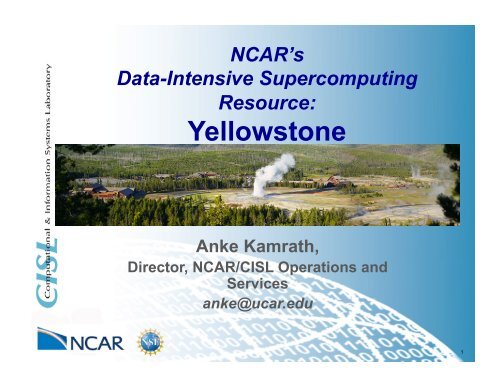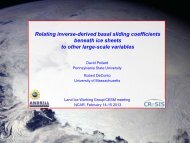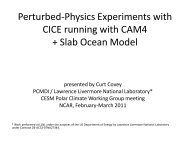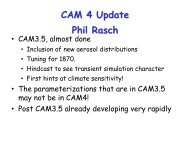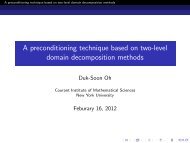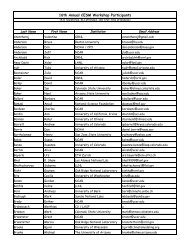Anke Kamrath - CESM - UCAR
Anke Kamrath - CESM - UCAR
Anke Kamrath - CESM - UCAR
Create successful ePaper yourself
Turn your PDF publications into a flip-book with our unique Google optimized e-Paper software.
NCAR’s<br />
Data-Intensive Supercomputing<br />
Resource:<br />
Yellowstone<br />
<strong>Anke</strong> <strong>Kamrath</strong>,<br />
Director, NCAR/CISL Operations and<br />
Services<br />
anke@ucar.edu<br />
1
to<br />
Changing the way we do<br />
“Process Centric”<br />
“Information Centric”<br />
science…<br />
2
Yellowstone Supercomputing Environment<br />
Geyser &<br />
Caldera<br />
DAV clusters<br />
Science Gateways<br />
RDA, ESG<br />
Yellowstone<br />
HPC resource, 1.50 PFLOPS peak<br />
High Bandwidth Low Latency HPC and I/O Networks<br />
FDR InfiniBand and 10Gb Ethernet<br />
1Gb/10Gb Ethernet (40Gb+ future)<br />
Data Transfer<br />
Services<br />
Remote Vis<br />
NCAR HPSS Archive<br />
100 PB capacity<br />
~15 PB/yr growth<br />
Partner Sites XSEDE Sites<br />
GLADE<br />
Central disk resource<br />
11 PB (2012), 16.4 PB (2014)<br />
3
Yellowstone<br />
High-Performance Computing Resource<br />
• Batch Computation<br />
– 72,288 cores total – 1.504 PFLOPs peak<br />
– 4,518 IBM dx360 M4 nodes – 16 cores, 32 GB memory per node<br />
– Intel Sandy Bridge EP processors with AVX – 2.6 GHz clock<br />
– 144.6 TB total DDR3-1600 memory<br />
– 28.9 Bluefire equivalents<br />
• High-Performance Interconnect<br />
– Mellanox FDR InfiniBand full fat-tree<br />
– 13.6 GB/s bidirectional bw/node<br />
–
GLADE<br />
(GLobally Accessible Data Environment)<br />
• 10.94 PB usable capacity � 16.42 PB usable (1Q2014)<br />
Estimated initial file system sizes<br />
– collections ≈ 2 PB RDA, CMIP5 data<br />
– scratch ≈ 5 PB shared, temporary space<br />
– projects ≈ 3 PB long-term, allocated space<br />
– users ≈ 1 PB medium-term work space<br />
• Disk Storage Subsystem<br />
– 76 IBM DCS3700 controllers & expansion drawers<br />
• 90 2-TB NL-SAS drives/controller<br />
• add 30 3-TB NL-SAS drives/controller (1Q2014)<br />
• GPFS NSD Servers<br />
– 91.8 GB/s aggregate I/O bandwidth; 19 IBM x3650 M4 nodes<br />
• I/O Aggregator Servers (GPFS, HPSS connectivity)<br />
– 10-GbE & FDR interfaces; 4 IBM x3650 M4 nodes<br />
• High-performance I/O interconnect to HPC & DAV<br />
– Mellanox FDR InfiniBand full fat-tree<br />
– 13.6 GB/s bidirectional bandwidth/node<br />
5
Bytes/flop on current NSF HPC Portfolio<br />
Yellowstone unique in NSF Portfolio<br />
TB TF bytes/flops<br />
NCSA Forge 600 153 3.92<br />
NCSA Blue Waters 25000 11500 2.17<br />
NICS Athena 100 166 0.60<br />
NICS Kraken 2400 1170 2.05<br />
PSC Blacklight 150 36 4.17<br />
TACC Lonestar4 1000 302 3.31<br />
TACC Ranger 1730 580 2.98<br />
SDSC Trestles 140 100 1.40<br />
SDSC Gordon 2000 341 5.87<br />
Total 5 centers 33120 14348 2.31<br />
NCAR's Yellowstone Phase 1 11000 1500 7.33<br />
NCAR's Yellowstone Phase 2 16400 1500 10.93<br />
6
Yellowstone Storage – Disk & Tape<br />
• GLADE - Central Filesystem<br />
– 11 PB (2012), growing to<br />
– 16.4 PB (2014)<br />
• HPSS – Archive<br />
– 16 PB (mid-2012), growing to<br />
– 30-40 PB by end of 2013<br />
• 2014 – Update Archive<br />
– 100+ PB<br />
• Ratio Archive/Filesystem<br />
– Current - 10:1<br />
– 2012-13 – 3:1<br />
– 2014 – 6:1<br />
• Still not enough storage…<br />
– Archive and disk allocations implemented to manage demand. Need<br />
150-200PB archive based on projections.<br />
7
Geyser and Caldera<br />
Data Analysis & Visualization Resource<br />
• Geyser: Large-memory system<br />
– 16 IBM x3850 nodes – Intel Westmere-EX processors<br />
– 40 cores, 1 TB memory, 1 NVIDIA GPU per node<br />
– Mellanox FDR full fat-tree interconnect<br />
• Caldera: GPU computation/visualization system<br />
– 16 IBM x360 M4 nodes – Intel Sandy Bridge EP/AVX<br />
– 16 cores, 64 GB memory per node<br />
– 2 NVIDIA GPUs per node<br />
– Mellanox FDR full fat-tree interconnect<br />
• Knights Corner system (Q2 2013 delivery)<br />
– Intel Many Integrated Core (MIC) architecture<br />
– 16 IBM Knights Corner nodes<br />
– 16 Sandy Bridge EP/AVX cores, 64 GB memory<br />
– 1 Knights Corner adapter per node<br />
– Mellanox FDR full fat-tree interconnect<br />
8
Yellowstone Power Efficiency vs Bluefire<br />
Processor 2.6 GHz Xeon<br />
E5<br />
Yellowstone Bluefire<br />
4.7 GHz<br />
POWER6<br />
Total Batch Processor Cores 72,288 3,744<br />
Batch portion peak TFLOPs 1500 72<br />
Power Consumption ~1.9 MW 540 kW<br />
Watts/peak GFLOP 1.3 7.5<br />
Peak MFLOP/Watt 800 133<br />
Average workload floating point<br />
efficiency<br />
Sustained MFLOPs/Watt (on NCAR<br />
workload)<br />
5.4%<br />
(estimate)<br />
3.9%<br />
(measured)<br />
~43 ~6<br />
Bluefire-equivalents 28.9 1<br />
For 3.5x more power, Yellowstone delivers 28.9x more<br />
computational performance than Bluefire.<br />
9
Yellowstone Schedule<br />
10
NWSC Installation<br />
11
When can users get going on this?<br />
• Yellowstone in Acceptance in August:<br />
– If all goes well, ready for users in September<br />
• Until its ready – we have:<br />
– Bluefire (~4-8 week overlap once Yellowstone<br />
in production)<br />
– Janus Cluster (similar to Yellowstone)<br />
• 16,416 cores total – 184 TFLOPs peak<br />
• 1,368 nodes – 12 cores, 24 GB memory per node<br />
• Intel Westmere processors – 2.8 GHz clock<br />
• 32.8 TB total memory<br />
• QDR InfiniBand interconnect<br />
• Red Hat Linux<br />
• Deployed by CU-Boulder in collaboration with NCAR<br />
• ~10% of the system allocated by NCAR<br />
• Small allocations to university, NCAR users<br />
• <strong>CESM</strong>, WRF ported and running<br />
• Key elements of NCAR software stack installed<br />
• www2.cisl.ucar.edu/docs/janus-cluster<br />
12<br />
12
Yellowstone Environment Lifetime Costs<br />
Yellowstone GLADE - Central Filesystem<br />
Geyser, Caldera HPSS Archive<br />
Maintenance & Support Utilities<br />
18%<br />
6%<br />
3%<br />
13%<br />
14%<br />
46%<br />
13
Many challenges ahead …<br />
(post-Yellowstone)<br />
• Follow-on System (~2015) Likely to Have:<br />
1. Xeon and Many-Cores (e.g., nVIDIA, MIC)<br />
• Need for improved science-FLOPS/watt.<br />
2. Less Memory/Core<br />
• Number of cores outpacing improvement in<br />
memory pricing<br />
• Need to live in smaller per core memory footprint<br />
(i.e., ~1 GB/core as compared with<br />
2 GB/core on yellowstone)<br />
3. Budget constrained storage environment<br />
• Cost of storage capacity/bandwidth is outpacing<br />
compute<br />
• We need to prepare now for these<br />
Challenges<br />
14
Historical FLOP/Power Efficiency<br />
on NCAR Systems<br />
Name Model<br />
Peak<br />
GFLOPs<br />
Sus<br />
GFLOPs<br />
Power<br />
(kW)<br />
Sus<br />
MFLOP/<br />
Watt<br />
Watt/<br />
Sus<br />
GFLOP<br />
Est'd<br />
Power<br />
Cost/yr<br />
chipeta CRI Cray J90se/24 4.8 1.58 7.5 0.21 4753 $5,625<br />
ute SGI Origin2000/128 64 7.85 51.1 0.15 6513 $38,325<br />
blackforest IBM SP/1308 (318) WH2/NH2 1,962 121.6 140.0 0.87 1151 $105,000<br />
bluesky IBM p690/32 (50) Regatta-H/Colony 8,320 343.6 415.0 0.83 1208 $311,250<br />
lightning IBM e325/2 (128) Opteron Linux cluster 1,144 63.8 48.0 1.33 753 $36,000<br />
bluevista IBM p575/8 (78) POWER5/HPS 4,742 347.6 210.6 1.65 606 $157,950<br />
blueice IBM p575/16 (112) POWER5+/HPS 13,312 1,000.2 325.4 3.07 325 $244,050<br />
Bluefire (2008)<br />
IBM Power 575/32 (128) POWER6<br />
DDR-IB 77,005 2,987.8 538.2 5.55 180 $403,654<br />
Frost (2009) IBM BlueGene/L (4096/2) 22,938 741.5 83.1 8.92 112 $62,325<br />
lynx Cray XT5m (912/76) 8,130 487.8 35.0 13.9 72 $26,250<br />
Yellowstone (2012) IBM iDataPlex/FDR-IB 1,503,590 80,950 1,900 42.6 23 $1,700,000<br />
next system??<br />
next system??<br />
Possible - Intel Xeon only<br />
estimates -> 10,000,000 500,000 5,000 100.0 10 $3,750,000<br />
Possible - Intel Xeon & GPUs<br />
estimates -> 40,000,000 500,000 3,000 166.7 6 $2,250,000<br />
15
What does a new supercomputer enable?<br />
Expanding the modeling envelope<br />
16<br />
16
Inefficient Use of Memory<br />
• Replicated Metadata<br />
– Describes the location of something else<br />
• eg: message passing schedule, domain decomposition<br />
– Consider: p i sends ‘n’ bytes to p j<br />
• Don’t store information about p j, p i on p k if k != i,j<br />
– High resolution version of CLM on 10K processors --> 29 TB<br />
– Ignorance is bliss! :-)<br />
• Excessive Global Arrays<br />
– global arrays: an array the size of the entire computational<br />
mesh<br />
– Persistent versus temporary global arrays<br />
– Low res ---> no big deal; High res --> can be fatal !<br />
– Example: CLM<br />
• Original: ~500<br />
• Now: 1 (temporary)<br />
17
Using less memory to<br />
get same science done<br />
Total memory usage for CLM<br />
50x<br />
18
Improving Data Workflow and<br />
Management<br />
• Today:<br />
– We are seeing many challenges with Data Analysis of CMIP5<br />
data<br />
• Atomic NCO commands very inefficient to transform the raw <strong>CESM</strong><br />
output into time series. Prevents use of buffering<br />
• NCAR GLADE GPFS 2MB Blocks, NETCDF3 10-150kB used – very<br />
inefficient. 10-20X too much data being moved.<br />
• Overall workflow complex and inefficient, and lacking automation<br />
• Work ahead:<br />
– Need improvements on all fronts<br />
• More efficient data management, scripts,<br />
• Thinking carefully about what you store, what should be done<br />
during the simulation phase rather than after the fact<br />
• Tuning of systems to better support workload<br />
• Much more…<br />
– Nearly unworkable “today” – won’t survive at all in future.<br />
19
In Conclusion<br />
• Excited about new<br />
science that will be<br />
enabled with<br />
Yellowstone!!<br />
• However, a lot of work<br />
ahead to prepare for<br />
Yellowstone followon….<br />
20
Questions<br />
21
Yellowstone Software<br />
• Compilers, Libraries, Debugger & Performance Tools<br />
– Intel Cluster Studio (Fortran, C++, performance & MPI libraries,<br />
trace collector & analyzer) 50 concurrent users<br />
– Intel VTune Amplifier XE performance optimizer 2 concurrent<br />
users<br />
– PGI CDK (Fortran, C, C++, pgdbg debugger, pgprof) 50 conc.<br />
users<br />
– PGI CDK GPU Version (Fortran, C, C++, pgdbg debugger,<br />
pgprof) for DAV systems only, 2 concurrent users<br />
– PathScale EckoPath (Fortran C, C++, PathDB debugger)<br />
20 concurrent users<br />
– Rogue Wave TotalView debugger 8,192 floating tokens<br />
– IBM Parallel Environment (POE), including IBM HPC Toolkit<br />
• System Software<br />
– LSF-HPC Batch Subsystem / Resource Manager<br />
• IBM has purchased Platform Computing, Inc., developers of LSF-HPC<br />
– Red Hat Enterprise Linux (RHEL) Version 6<br />
– IBM General Parallel Filesystem (GPFS)<br />
– Mellanox Universal Fabric Manager<br />
– IBM xCAT cluster administration toolkit<br />
22


